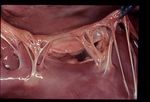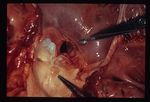Difference between revisions of "Ventricular Septal Defect"
| Line 1: | Line 1: | ||
| − | [[Image:VSD1.jpg|thumb|right| | + | {{review}} |
| + | == Introduction == | ||
| + | [[Image:VSD1.jpg|thumb|right|150px|<small><center><b>Ventricular septal defect</b>. Courtesy of A. Jefferies</center></small>]] | ||
| + | [[Image:VSD2.jpg|thumb|right|150px|<small><center><b>Ventricular septal defect</b>. Courtesy of A. Jefferies</center></small>]] | ||
| + | Ventricular Septal Defect, also known as '''VSD''', is the most common congenital cardiac abnormality in large animals and the second most common congenital cardiac abnormality in cat. It does occur in dogs, but less frequently. Predisposed breeds include Keeshonds, English Springer Spaniel, English Bulldog and West Highland White Terrier. | ||
| − | + | Ventricular defects are usually in the '''membranous area''' of the interventricular septum. On the right ventricle, the septal defect usually occurs below the septal leaflet of the tricuspid valve. On the left ventricle, the septal defect usually occurs under the aortic valve. | |
| − | + | Ventricular Septal Defects can occur alone or in combination with other congenital malformations. Usually blood flows from the higher pressure left ventricle through the shunt to the lower pressure right ventricle. Left to right shunting causes volume overload of the pulmonary circulation and consequently the left atrium and ventricle. The consequences of L-R shunting are [[Heart Failure, Left-Sided|left-sided congestive heart failure]] and [[Pulmonary Hypertension|pulmonary hypertension]]. Shunting can be reversed from L-R towards R-L if pulmonary hypertension increases the pressure on the right side of the heart and/or there is also [[Pulmonic Stenosis|pulmonic stenosis]] (Eisenmenger's Physiology see below). A R-L shunt would allow unoxygenated blood into the systemic circulation resulting in arterial hypoxaemia. Increased amounts of blood into the systemic circulation causes an increased right sided pressure load. The defect is often associated with other conditions e.g. [[Tetralogy of Fallot]]. | |
| − | |||
| − | |||
| − | |||
| − | |||
| − | |||
| − | Ventricular Septal Defects can occur alone or in combination with other congenital malformations. Usually blood flows from the higher pressure left ventricle through the shunt to the lower pressure right ventricle. Left to right shunting causes volume overload of the pulmonary circulation and consequently the left atrium and ventricle. The consequences of L-R shunting are left sided congestive heart failure and pulmonary hypertension. | ||
| − | |||
| − | |||
'''Eisenmenger's Syndrome''': chronic pulmonary overcirculation results in pulmonary hypertension and increased right-sided pressure. This facilitates right to left shunting and reduced lung perfusion, leading on to cyanosis. | '''Eisenmenger's Syndrome''': chronic pulmonary overcirculation results in pulmonary hypertension and increased right-sided pressure. This facilitates right to left shunting and reduced lung perfusion, leading on to cyanosis. | ||
| − | + | == Clinical Signs == | |
| − | + | Coughing, exercise intolerance, left-sided congestive heart failure, [[Heart Failure, Right-Sided|right-sided heart failure]] and cyanosis (with R-L shunt) are all possible clinical signs. With smaller defects, the condition can be asymptomatic. | |
| − | + | == Diagnosis == | |
| − | + | History and clinical signs would be presumptive of a heart condition. | |
| − | + | On physical examination, a '''holosystolic murmur over left apex and right sternal border''' (diagonal murmur) can be detected as well as a '''systolic murmur over pulmonic valve''' (pulmonic stenosis) and '''diastolic murmur over aortic valve''' (aortic regurgitation). There may also be a '''murmur''' from mitral regurgitation (caused by left ventricular dilation). | |
| − | |||
| − | |||
| − | |||
| − | On physical examination, a holosystolic murmur over left apex and right sternal border (diagonal murmur) can be detected as well as a systolic murmur over pulmonic valve (pulmonic stenosis) and diastolic murmur over aortic valve (aortic regurgitation). There may also be a murmur from mitral regurgitation (caused by left ventricular dilation). | ||
Radiographs would show a generally normal heart with small defects such as pulmonary overcirculation, left or right sided heart enlargement (due to which side the shunt went) and enlargement of the pulmonary arteries. | Radiographs would show a generally normal heart with small defects such as pulmonary overcirculation, left or right sided heart enlargement (due to which side the shunt went) and enlargement of the pulmonary arteries. | ||
| Line 33: | Line 25: | ||
Echocardiography with doppler would show blood shunting through defect. | Echocardiography with doppler would show blood shunting through defect. | ||
| − | An | + | An Electrocardiograph (ECG) will show left sided enlargement (L-R shunt), right ventricular hypertrophy (R-L shunt), arrhythmias and a wide or notched Q wave showing abnormal septal depolarization. |
| − | |||
| − | |||
| − | |||
| − | |||
| − | == Treatment | + | == Treatment == |
| − | + | Treatment may be unnecessary as the defect may close on its own (or is small enough not to cause any clinical signs). Severe cases will usually need medications; drugs to decrease volume through the shunt (arterial vasodilators for R-L shunt) and drugs to combat heart failure. Surgery may also be necessary in these cases to close the septal defect (open heart surgery rarely performed in veterinary patients) or to perform pulmonary artery banding (palliative surgical procedure to decrease left to right shunting). | |
The use of vasodilators and the surgical procedures above are contraindicated with a right to left shunt. | The use of vasodilators and the surgical procedures above are contraindicated with a right to left shunt. | ||
| − | + | == Prognosis == | |
| − | |||
| − | == Prognosis | ||
In mild to moderate cases the prognosis is excellent. In severe cases, the prognosis is guarded (L-R shunts) and poor (R-L shunts). | In mild to moderate cases the prognosis is excellent. In severe cases, the prognosis is guarded (L-R shunts) and poor (R-L shunts). | ||
| − | + | == Test yourself with the Developmental Pathology Flashcards == | |
| − | + | [[Cardiovascular Developmental Pathology Flashcards]] | |
| − | == References | + | == References == |
| − | Merck & Co (2008) The Merck Veterinary Manual (Eighth Edition) Merial | + | Merck & Co (2008) The Merck Veterinary Manual (Eighth Edition) Merial |
| − | + | Nelson, R.W. and Couto, C.G. (2009) Small Animal Internal Medicine (Fourth Edition) Mosby Elsevier. | |
| − | + | Pasquini, C, Pasquini, S, Woods, P (2005) Guide to Equine Clinics Volume 1: Equine Medicine (Third edition), SUDZ Publishing. | |
| − | |||
| − | |||
| − | |||
| − | |||
| − | + | [[Category:Cardiovascular_System_-_Developmental_Pathology]] [[Category:Expert_Review]] [[Category:Cardiac_Diseases_-_Dog]] [[Category:Cardiac_Diseases_-_Cat]] [[Category:Cardiac_Diseases_-_Horse]] [[Category:Cardiac_Diseases_-_Cattle]] [[Category:Cardiac_Diseases_-_Pig]] | |
Revision as of 21:02, 13 March 2011
| This article has been peer reviewed but is awaiting expert review. If you would like to help with this, please see more information about expert reviewing. |
Introduction
Ventricular Septal Defect, also known as VSD, is the most common congenital cardiac abnormality in large animals and the second most common congenital cardiac abnormality in cat. It does occur in dogs, but less frequently. Predisposed breeds include Keeshonds, English Springer Spaniel, English Bulldog and West Highland White Terrier.
Ventricular defects are usually in the membranous area of the interventricular septum. On the right ventricle, the septal defect usually occurs below the septal leaflet of the tricuspid valve. On the left ventricle, the septal defect usually occurs under the aortic valve.
Ventricular Septal Defects can occur alone or in combination with other congenital malformations. Usually blood flows from the higher pressure left ventricle through the shunt to the lower pressure right ventricle. Left to right shunting causes volume overload of the pulmonary circulation and consequently the left atrium and ventricle. The consequences of L-R shunting are left-sided congestive heart failure and pulmonary hypertension. Shunting can be reversed from L-R towards R-L if pulmonary hypertension increases the pressure on the right side of the heart and/or there is also pulmonic stenosis (Eisenmenger's Physiology see below). A R-L shunt would allow unoxygenated blood into the systemic circulation resulting in arterial hypoxaemia. Increased amounts of blood into the systemic circulation causes an increased right sided pressure load. The defect is often associated with other conditions e.g. Tetralogy of Fallot.
Eisenmenger's Syndrome: chronic pulmonary overcirculation results in pulmonary hypertension and increased right-sided pressure. This facilitates right to left shunting and reduced lung perfusion, leading on to cyanosis.
Clinical Signs
Coughing, exercise intolerance, left-sided congestive heart failure, right-sided heart failure and cyanosis (with R-L shunt) are all possible clinical signs. With smaller defects, the condition can be asymptomatic.
Diagnosis
History and clinical signs would be presumptive of a heart condition.
On physical examination, a holosystolic murmur over left apex and right sternal border (diagonal murmur) can be detected as well as a systolic murmur over pulmonic valve (pulmonic stenosis) and diastolic murmur over aortic valve (aortic regurgitation). There may also be a murmur from mitral regurgitation (caused by left ventricular dilation).
Radiographs would show a generally normal heart with small defects such as pulmonary overcirculation, left or right sided heart enlargement (due to which side the shunt went) and enlargement of the pulmonary arteries.
Echocardiography with doppler would show blood shunting through defect.
An Electrocardiograph (ECG) will show left sided enlargement (L-R shunt), right ventricular hypertrophy (R-L shunt), arrhythmias and a wide or notched Q wave showing abnormal septal depolarization.
Treatment
Treatment may be unnecessary as the defect may close on its own (or is small enough not to cause any clinical signs). Severe cases will usually need medications; drugs to decrease volume through the shunt (arterial vasodilators for R-L shunt) and drugs to combat heart failure. Surgery may also be necessary in these cases to close the septal defect (open heart surgery rarely performed in veterinary patients) or to perform pulmonary artery banding (palliative surgical procedure to decrease left to right shunting).
The use of vasodilators and the surgical procedures above are contraindicated with a right to left shunt.
Prognosis
In mild to moderate cases the prognosis is excellent. In severe cases, the prognosis is guarded (L-R shunts) and poor (R-L shunts).
Test yourself with the Developmental Pathology Flashcards
Cardiovascular Developmental Pathology Flashcards
References
Merck & Co (2008) The Merck Veterinary Manual (Eighth Edition) Merial
Nelson, R.W. and Couto, C.G. (2009) Small Animal Internal Medicine (Fourth Edition) Mosby Elsevier.
Pasquini, C, Pasquini, S, Woods, P (2005) Guide to Equine Clinics Volume 1: Equine Medicine (Third edition), SUDZ Publishing.

